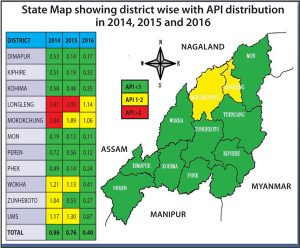Nagaland
Longleng and Mokokchung leads in malaria prevalence rate

Our Correspondent
Kohima, April 25 (EMN): Since the outbreak of malaria at Mangkolemba under Mokokchung district in 2009 resulting in 20 deaths, cases of malaria in the state over the years have drastically come down with 828 cases and zero deaths in the year 2016.
This was informed by joint director and state programme officer NVBDCP, Dr Kevichusa Medikhru at a press conference during the observation of World Malaria Day (WMD) on the theme ‘End malaria for good’ at his office chamber, directorate of Health and Family Welfare.
Highlighting the status of malaria cases across the state as a whole, Dr Medikhru said Nagaland falls under category 2 (pre-elimination phase) with an Annual Parasite Incidence (API) of less than 1 case per 1000 population at risk.
At present, Longleng with 1.14 which has come down from 3.67 during 2014 and Mokokchung at 1.06 which came down from 2.84 during 2014 have the highest prevalent rate of malaria.
He said the department is narrowing down its surveillance in Longleng and Wokha districts, where surveillance has been not active in the last few years to achieve elimination of malaria. The department’s main concern, he informed are those having international borders Mon, Tuensang, Kiphire and Phek.
Dr Medikhru said it is actively monitoring the international cross-border areas to contain and prevent spread of malaria into the state.
With the global fund from the Government of India, the department is said to have distributed 9 lakhs 14 thousand Long-lasting Insecticidal Nets (LLINs) treated bed nets across the state during 2016.
He however, lamented that many people don’t use the nets, which has a shelf life of 5 years and has requested all to use the nets to prevent malaria. He also expressed concern by the people’s refusal for Indoor Residual Spraying (IRS) – Dichlorodiphenyltrichloroethane (DDT), though it is been abundantly use in gardening which is very harmful to health.
Deputy Director, Dr Neisakho Kera also informed that very soon it will be issuing a notice to all the government and private health sectors declaring malaria as ‘notifiable disease’ wherein, all the private health sectors will have to report any positive detection t the concerned authority.
Dr Medikhru also expressed concern that with the early rains this year; Dimapur could be a ‘time bomb’ for outbreak of malaria with stagnation of water and clogged drains. He said the department has surveyed the drainages in Dimapur town which has a total of 1600 km and released Gambusia affins – mosquito larvae eating fish into the drainages.
Towards achieving malaria elimination in the state 2030, Dr Medikhru implied on the importance of the involvement of other intersectoral departments like Urban Development, Agriculture, Public Health Engineering, Work and Housing, Municipals, Fisheries, Education, NGOs, Private Health Providers etc.
He also fervently appealed for community participation to contribute by keeping the surroundings clean, doing away with stagnant water which encouraged mosquito breeding, accepting IRS, daily usage of LLIN and educating oneself on the aspects of prevention and awareness of malaria.

